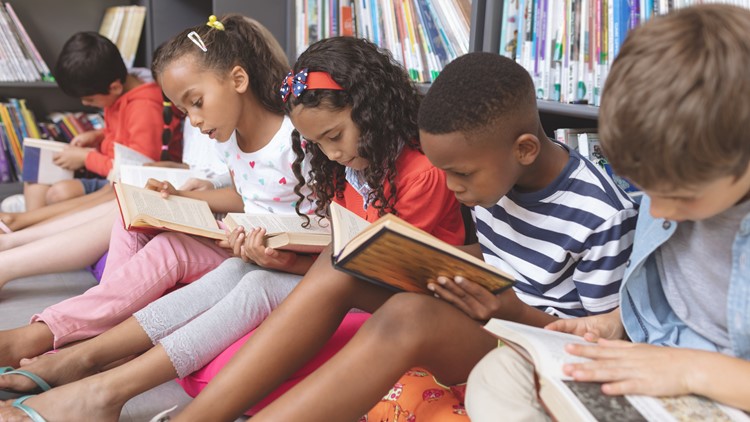PORTLAND, Ore. — U.S. students including those in Oregon will pay a staggering academic toll from the prolonged coronavirus-induced school shutdown, new research conducted in Portland based on 5 million test scores indicates.
Compared to how much they would have learned in a normal school year, elementary and middle school students are likely to start school in the fall equipped with only about 70% of those reading and writing skills and with 50% or less of the expected gains in math, according to the research, conducted since the pandemic shuttered nearly all U.S. schools.
While the projected learning losses are estimates, it’s clear it will likely take years, even in a best-case scenario, to fully remedy the hit to most students’ academic trajectories, say researchers at Northwest Evaluation Association.
And children in families least equipped to help them during the unplanned and unprecedented pause in normal schooling, due to financial woes, lack of digital equipment or know-how and racial inequities, will surely be harmed the most, they and others say.
“This is the longest break in an education that any kid who has started kindergarten has experienced” in the history of modern U.S. education, says Chris Minnich, the test group’s chief executive. “It’s going to be really hard on teachers who are going to have wider gaps (in their students’ skill levels) than they ever have” this fall.
Minnich and officials at the Oregon Department of Education tried to offer hope, however, pointing to strategies they say could lessen academic erosion for this generation of students. They include:
- Offer summer catch-up sessions to students most likely to fall far behind, including students of color, those in poverty, those whose families speak languages other than English and those with special education needs.
- Start the school year a couple of weeks early, when possible, or at least provide teachers with extra training and a wider range of curriculum materials during the ramp-up to schools reopening.
- Deploy additional testing shortly after school restarts so teachers can better match instruction to students’ needs.
- Draw on community resources, whether that means posting math questions in grocery stores or sharing highly educated tech-savvy parents’ tips with adults in low-income communities, to help reinforce learning during time out of school.
- In the fall, shift after-school programming such as Multnomah County’s SUN School operations to focus more on academics, given the need to make up instructional time.
The testing agency behind the new research, a non-profit based in Portland’s Old Town Chinatown neighborhood, sprouted in the 1970s from early testing expertise that had built up in Portland Public Schools, long before testing students in nearly every grade every year become standard practice in the U.S. Since its inception, Northwest Evaluation Association has specialized in tests that measure each student’s growth over the course of a school year and from spring to fall, rather than how high or low each child compares at year’s end to a grade-level standard.
One in four U.S. children, including those in Portland, Woodburn and West Linn-Wilsonville and more than 20 other Oregon districts, attend schools that use the Portland agency’s signature test, Measures of Academic Progress. Students typically take those tests in the fall, the winter and again in the spring.
Scores on those tests and others have shown it’s normal for students to lose substantial ground on academics over the summer break, which typically lasts about 10 weeks. But this year’s unprecedented closures, which will subtract about 12 weeks from Oregon’s school year, mean students are expected to lose far more ground, as their skills will erode rather than grow during that time, despite the best efforts at distance learning, the testing outfit’s researchers say.
Although reading gains tend to tail off in the final months of the school year anyway, according to their research, the typical student’s math skills improve steadily all school year, which explains in part why the learning losses will be particularly severe in math, the researchers report.
In addition, most parents and other adults who try to help students stay on track while schools are shuttered are ill equipped to pick up math teaching where schools left off, said Beth Tarasawa, Northwest Evaluation Association’s executive vice president of research.
“We know there are a fair amount of parents who, even if they have the will, will struggle to help their kids on the math side,” Tarasawa said.
During the current ad hoc distance learning period, students, families and educators are not, for the most part, behaving as if it’s full-on summer vacation, researchers acknowledge.
Most schools are trying to offer at least a couple hours of online instruction per day, though that is much less teaching time than during the regular school year. And parents are trying to engage their children in schoolwork, whether helping them log into and stick with school Zoom sessions or turning to gardening, cooking, story times and art projects to keep minds engaged and math skills and vocabularies strong.
But many parents are quickly realizing that teaching is best left to professionals, whose work they may not have fully appreciated. And children whose parents must work outside the home to maintain income or do essential work, those whose families lack enough up-to-date computers or other equipment to give each child one to use, those without reliable or any internet access, those who speak languages other than English and others with special circumstances are least likely to benefit from distance and at-home instruction.
Nothing, Minnich said, can match the power of a teacher interacting face-to-face with students he or she knows well.
“The antidote to this is time with teachers,” he said. “Teachers are the key to this. We need to get teachers in front of kids, and districts should think creatively about … time.”
The research findings are discouraging, Minnich acknowledged, but they’re important, he said. His nonprofit’s latest findings apply only to students in grades three through eight, he noted, but his research team will next dig into evidence about learning losses in kindergarten through grade two. In the meantime, he said, it’s important that policymakers, those with the power to shift money and personnel, and individual Oregon communities address the enormous loss of learning.
Officials at the Oregon Department of Education say they’re doing just that. Alexa Pearson, the agency’s director of standards and instructional support, read the research and doesn’t doubt its core findings. She said the department is providing school districts with guidance and resources to help them keep students learning as best as possible. And, she said, it will provide even more help when school restarts in the fall, including drawing on the best available suggestions and resources from the national associations of English and math teachers.
But, she noted, the department isn’t focused solely on helping schools support students academically.
“Students will more than likely experience consequences both academic and social-emotional from the impact of extended school closure due to COVID-19,” she said. So helping districts make sure students are fed and have emotional support are a big priority as well, Pearson said.
Dan Farley, the department’s director of assessment, says testing to measure learning loss should not be the top priority when schools re-open. Teachers checking in with students emotionally and getting to know them as people should come first, he said.
But without spring test scores to give teachers and curriculum leaders information about where their incoming students stand, it will be important to figure that out early in the year, he said. That will enable instruction to start where students are, not where state standards say they’re expected to be. And to that end, he said, he has pointed districts to testing resources and is working to make a whole suite of progress-monitoring tests from the consortium that makes Oregon’s official end-of-year standardized tests available for free to all Oregon districts.
For some students, taking a test designed for the grade they were in when school closed rather than the grade they’ve just entered may make sense, given what the research show about learning losses, Farley said.
Districts could use those tests “from the prior grade level to identify areas where student learning requires the most attention and focus instructional time and resources getting students caught up in those areas,” he said.
Contrary to conventional wisdom, research based on Measures of Academic Progress test results and other tests does not indicate that low-income students and students of color lose more ground than higher income and white students during the summer. Instead, most racial and income-linked achievement gaps stem from early childhood, then expand while children and teens are in school.
Widely circulated findings show the so-called “summer slide” disproportionately harms disadvantaged students and largely exempts offspring of well-off families. But that conclusion was largely based on findings from limited testing in Baltimore in the 1980s and has been debunked, Tarasawa and other researchers have found.
Megan Kuhfeld, a Northwest Evaluation Association research scientist and lead author of the new research, said when she and other researchers examined more sophisticated test results from much larger groups of students, they didn’t “find gaps widen by race, ethnicity or income status” during the summer.
Especially among elementary and middle school children, “what we see typically is that parents of all different class levels treat summer as a vacation, where kids get to be kids and not do academics,” she said.
The situation will be very different during the current school closures, however, she and Tarasawa said. Both said they are certain that academic gaps based on race and income will widen – and need to be prioritized as policymakers, educators and lawmakers work on fixes.
“During this time of really unequal access to technology, of parents losing jobs … we’re going to see large variability by poverty and race,” Kuhfeld said. “Middle class parents are more able to support their kids and provide the technology and internet to keep their kids learning. Poorer families are trying to put food on the table ... Poorer families are much more hurt by these school closures.”
Oregon schools and educators are going to need to prepare for a years-long response to repair the damage, Tarasawa said, and researchers, lawmakers and policymakers will need to support them.
Teachers will face greater demands and will need extra information and help, Kuhfeld said. “It’s easy to say this but not easy to implement it. Teachers must get preparation to teach both on- and off-grade standards, with so many kids coming in a grade or two behind.”
She said it will be imperative “to do the best we can to support teachers in doing that. That’s not going to be easy. But that is what kids need.”
-- Betsy Hammond; betsyhammond@oregonian.com; @chalkup
This article was originally published by The Oregonian/Oregonlive, one of more than a dozen news organizations throughout the state sharing their coverage of the novel coronavirus outbreak to help inform Oregonians about this evolving health issue.



